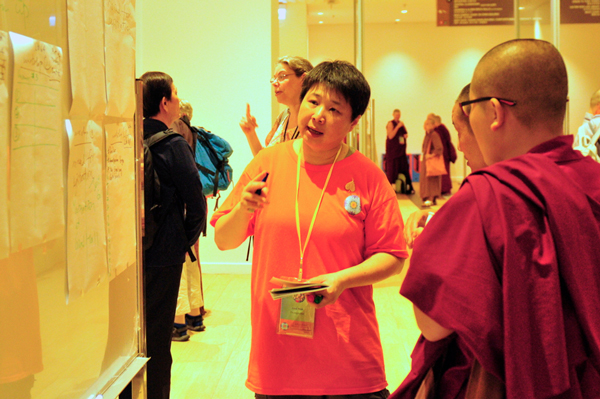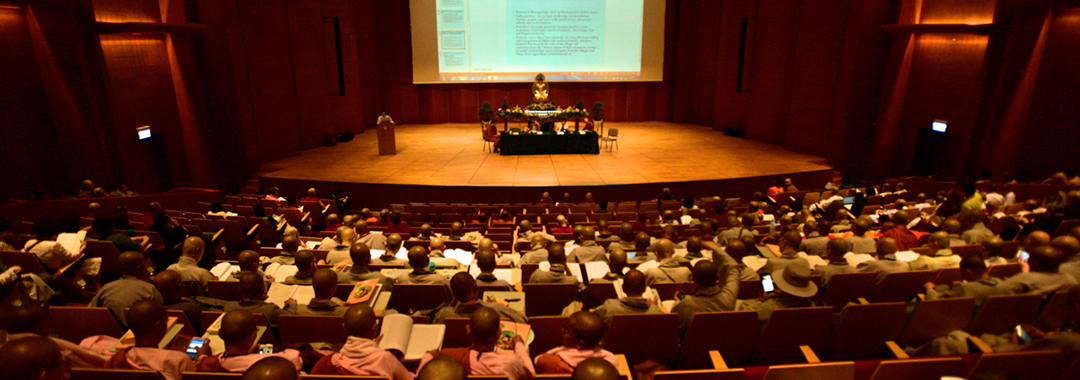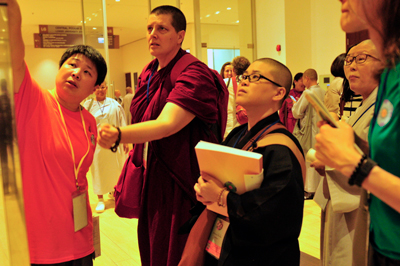
Preparing for an international conference #1 - The 15th. Sakyadhita International Conference, Hong Kong.
국제대회를 준비 하다 - 제 15차 샤카디타 홍콩대회
샤카디타 코리아의 편집위원회에서는 오는 2023년에 한국에서 치루게 될 제18차 샤카디타 세계여성불자대회의 성공을 위해 지난 샤카디타 대회를 준비했던 실무자를 대상으로 인터뷰를 기획했다. 먼저 2017년 홍콩에서 열린 제15차 대회를 성료하는 데에 큰 역할을 맡았던 Aosi Mak (오씨 막)님에게 대회 준비에 대해 물어본다.
5년이 지난 지금 다시 생각해봐도 홍콩에서 열린 제 15차 샤카디타 대회가 아무 문제 없이 순조롭게 성공리에 진행 되었다는 사실이 믿기지 않는다. 불법승 삼보가 대회를 이끌어준 덕분이라고 감사히 생각한다. - Aosi Mak
1. 대회를 개최하는 데에 있어서 가장 중요했던 내용은 무엇이었나요?
- 준비를 일찍 시작해야 합니다. (업무에 따라 마감을 달리 잡을 것)
- 조직에 신경을 써야 합니다.
① 대회 전: 지원금/자금과 예산안 짜기, 자원- 인력과 물자를 중요한 순서대로 마련, 개최 장소의 규모와 필요한 시설 파악, 실행 계획 수립, 등록 웹사이트 구축과 일정 분류, 스탭과 자원봉사자 모집, 가장 중요한 것은 대회 일정의 조율로 행사와 그에 따른 장소를 적절하게 미리 정해야 합니다. 행사의 성공 여부는 여기에 달려있기 때문입니다.
② 대회 중: 대회 전 후를 위한 서포트와 물자.
③ 대회 후: 관광 장소들을 여러 차례 방문해서 결정해야 합니다. - 확실하고 분명한 소통
- 업무 분담 그룹 형성(책임감 있는 사람들로 그룹 형성)
- 간단한 백업 플랜과 응급 시 대응안 마련
- 다행히 참가자 수가 가장 많은 한국과 베트남은 그쪽에 담당자가 있었습니다.
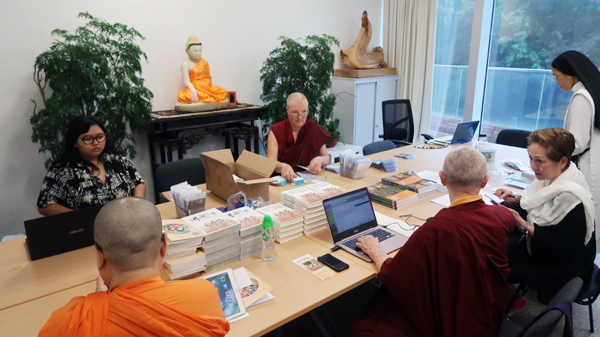
2. 샤카디타 인터내셔널 대회를 개최하기 위한 후원금 모집을 어떤 방식으로 했나요?
- 정부 혹은 ‘돈이 많은’ 단체를 찾아갔습니다. 세세한 계획보다 정확한 목표 설정이 중요합니다. 지난 대회의 사진들을 준비해 갔습니다. 한국 개최를 위해 지난 2017년 대회 때의 사진들을 참고하세요. 300명 이상의 비구니 스님들과 한국과 베트남 등의 해외 참가자, 발표자, 워크숍 진행자, 스탭과 자원봉사자, 공연자, 언론 기자 등을 합해서 약 700명이 참가했습니다.
3. 자원봉사자의 모집과 교육은 어떻게 했나요?
- 시간 부족으로 이 부분에 있어서 미흡한 점이 있었습니다. 저는 대회 시작 40일 전부터 준비에 참여했습니다.
- 그룹별로 담당자를 정해서 일주일 남짓의 기간 안에 준비를 해낼 수 있었습니다.
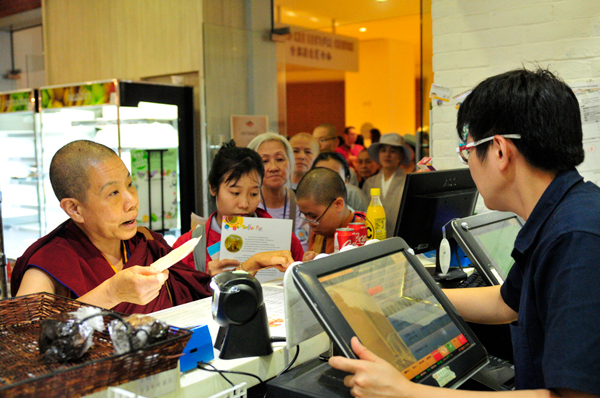
4. 대회 중 참가자들의 식사 문제는 어떻게 하셨는지요?
- 2017년 홍콩 대회는 홍콩대학에서 열렸고, 그 주변에 식당들이 많았기 때문에 참가자들의 식사 문제는 없었습니다. 또한 식권제를 적용했기 때문에 각자 원하는 식당에 줄을 서면 됐습니다. 식당 앞에서 줄을 길게 서야 하는 경우도 있었습니다. 잘 알다시피 그룹별 담당자들의 도움이 컸습니다. 무전기로 자주 서로 상황 업데이트를 하기도 했습니다.
5. 대회를 마치고 사찰 방문이 있었습니다. 관광 기획과 진행 방법, 가장 힘들었던 점에 대해 말씀해 주세요.
- 두 그룹으로 나누어서 이틀 동안의 관광이 있었습니다.
- 방문 할 장소들을 정한 다음 숙박 시설과 수용 가능 인원, 특정 행사 여부를 확인 해야 합니다.
- 장소 간 소요되는 운행 시간을 포함한 일정을 잡고 교통 수단, 예를 들어 버스 진입이 가능한지의 여부와 주차 관련 사항들을 확인합니다.
- 버스에 봉사자 한 두 명이 동승했습니다.
- 미리 준비를 하고 모임 장소와 출발 시간에 관해 참가자들과 사전 조율을 하면 특별히 문제될 일은 없습니다. 날씨 상황에 대비해서 우산과 물 등을 미리 준비했습니다. 홍콩의 여름은 매우 습하고 덥기 때문에 웰컴 패키지에 부채와 손수건, 물을 준비했습니다.
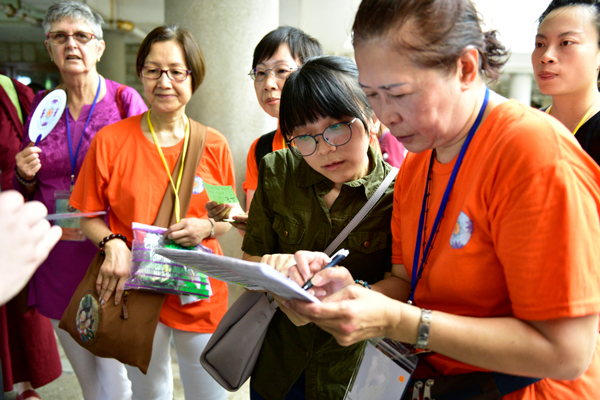
6. 대회 개최국의 실무자로서 당시의 경험과 생각들에 대해 말씀해주세요.
- 공유하고픈 일들은 많지만 가장 중요한 것은 상대방 즉 참가자, 스탭과 봉사자 그리고 기획자의 입장에서 생각을 해야 합니다. 사전 준비를 가능하면 일찍 시작해서 행사 준비에 관한 충분한 설명과 만일의 사태에 대비할 수 있도록 해야 합니다.
- 저는 5월 둘째주부터 실무팀에 뒤늦게 합류 했습니다만 아무것도 정해진 것이 없어서 6월 말까지 하루에 14-16시간 일을 했었죠. 렉셰스님과 연락을 자주 했어야 했는데 스님은 계속 여러 나라를 다니셔야 해서 연락이 쉽지 않았어요. 그래서 시간이 가장 많이 걸리고 미리 해야 할 일부터 했습니다. 그 다음은 대회 일정을 계획하는데 대부분의 시간을 할애했습니다. 프로그램 책자를 만들기 위해 인쇄소에 맡겨야 하는 8일전까지 일정을 점검하고 업데이트 했습니다.
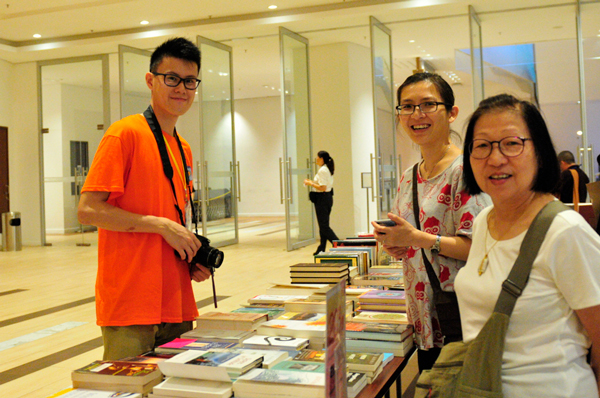
7. 한국이 다음 18차 대회를 개최하게 되었습니다. 샤카디타 코리아에게 해주실 조언이 있으시다면?
- 너그럽고 친절한 마음을 가지세요! 여러 사람이 힘을 합해서 많은 이들에게, 특히 샤카디타를 위해 널리 이롭게 하는 일이니까요.
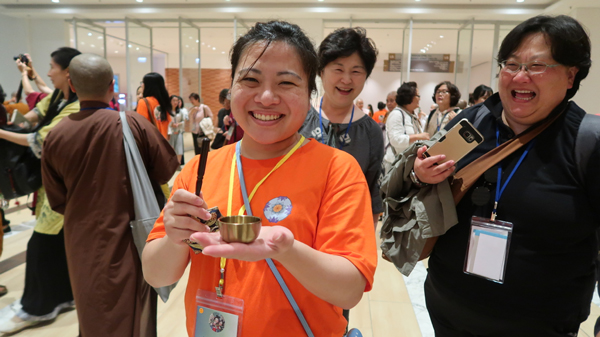
8. 대회 준비 실무자로서 보람이 있으셨겠네요?
- 참가자 모두가 만족해 했고 뜻 깊고 보람 있는 시간이었다고 생각했습니다. 모두가 안전하고 건강하게 잘 마쳤습니다.
9. 지켜야 할 사항들은 어떤 것들이 있나요?
- 아주 많죠. 주요 임무마다 각각 규칙이 있어요.
10. 대회를 개최한 나라로서 긍정적 영향은 어떤 것들이 있었다고 생각하시나요?
- 긍정적인 영향은 많았지만 요약하자면 다음과 같습니다.
- 샤카디타를 중심으로 결속 - 서로를 이해하고 돕고 함께 어려운 일들을 해결하는 등 협력 그리고 새로운 친구도 만들 수 있었어요.
- 지식의 공유 - 불교 뿐만 아니라 워크숍과 문화 공연과 관광을 통해 다양한 문화를 접하게 되었습니다.
- 사무량심을 행할 기회가 되었습니다.
1. What do you think was the most important factor when deciding the hosting venues?
- Start early (have deadline for different tasks)
- Good organization:
a) pre-conference (funding and budgeting; resources: both manpower and materials (what are crucial and critical versus what is not); venue capacity and arrangements (depending on the functions), logistics (participants, staff & volunteers, materials including storage); managing registration data (setup registration website properly and sort out date), recruit staffs/volunteers; and most importantly: conference schedule (events and venues, as everything else evolve base on this).
b) during conference (front and back end support, and resources)(lots of back end support tasks)
c) post-conference (meetings and site visits) - Very clear communication.
- Delegation of tasks (form proper groups of responsible people)
- Back-up plan (even just a vague one) and emergency plan (Luckily the biggest groups, Korean (Dr. Eun-su and Lunah) and Vietnamese groups have their own group coordinators.)
2. To host the Sakyadhita International Conference, how did you raise the funds?
- Go to the big fellows (supporters and government, if any), show not elaborated plan (not very detail needed) but aims must be clear, past events photo (can use the one in 2017 event, hosted over 300 bhikkhunis, overseas participants, mostly Korean and Vietnamese; overall around 700 participants (including guest speakers, workshop hosts, staffs, volunteers and performance artists, journalist, etc.)
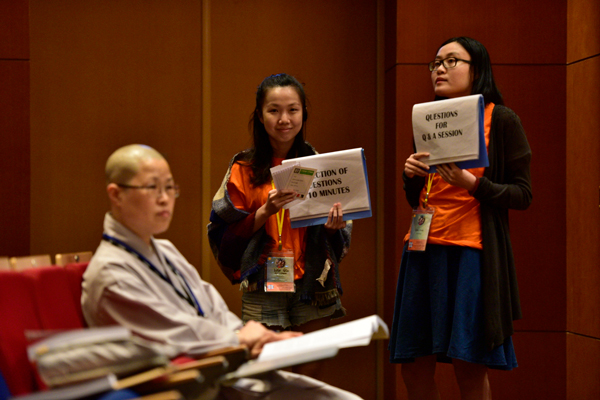
3. How did you organize and train the volunteers?
- We did a poor job on this part, because of limited time we have. (I was involved less than 40 days before the conference, and everything was up to the very last minutes).
- Luckily, we have assigned different group leaders and they took on the role in very short time (less than a week).
4. During the Conference how did you cater for the participants and what do you think was difficult in catering?
- For 2017 HK event, there weren’t too much difficulty in catering participants (because the venue is HKU campus, hence there are several restaurants for participants to choose and we used coupon systems, participants choose own restaurant to line up; although the line up was a bit longer than usual, which caused delay in getting food.) And participant group coordinators were very helpful (can ask Lunah), we communicate frequently on issues and updates. Also had walkie talkies.
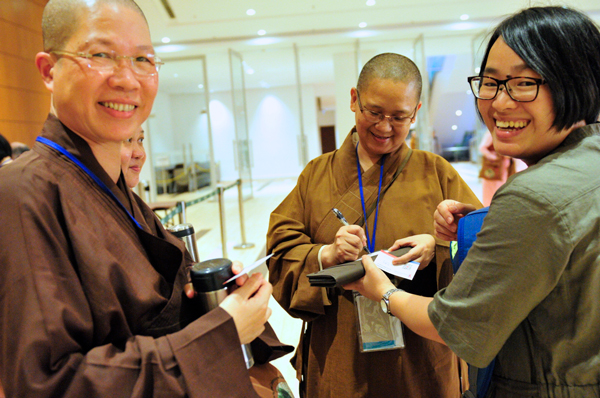
5. There have been temple tours after the Conference. How did you plan and proceed the tours?What was the difficult part when proceeding the tour?
- Yes, there was two full day tours (A and B groups, to different venues).
- First identify the sites to visit, and confirm possibility of accommodation (and how many people allowed) and events at those sites.
- Work out the schedules (include traveling time) and transportation requirements (vehicles and parking).
- We had one to two volunteers travel together with participants on the buses to each site.
- No very major difficulty if arranged ahead of time and communicate clearly with the participants (gathering and departure time and place). Must take weather into consideration and have water arranged on each bus, umbrella if needed. Because 2017 event was summer and HK is very humid and hot, therefore in our welcome package, a hand fan, handkerchief and water bottle were included.
6. As an executive manager of the hosting country, would you share your experience and opinions?
- Wow, there is a lot to share, but most importantly is thinking in the position of others (participants, staff/volunteers, and organizer), start very early have proper rundown of events and arrangements, contingency planning.
- I joined the organization team second week of May (which is very late start, nothing was in place, so I worked like 14~16 hours every day until end of June) because need to communicate with Venerable Lakshe and she was travelling to different places). So I planned what take most time and can be done early, then spent a lot of time on the conference programme (I did the programme booklet, spent daily updating/revising until deadline is 8 days before the conference because needed to print).
7. Korea is hosting the next 18th. conference. Do you have any advice for us?
- Have a big heart!JKeep in mind is a join force and is for the benefit of many, specially Sakyadhita.
8. Would you tell us what made you feel rewarded as an executive manager of the Conference?
- • Participants enjoyed the entire revenue, found it meaningful and time well spent, everyone was safe and healthy.
9. What are the dos and don’ts?
- So many, each key task has many dos and don’ts.
10. What positive influences on the participants from your own country were there when hosting the Conference?
- There are many, but can boil down to three key points: a) solidarity of Sakyadhita (mutual support through share understanding, difficulties, challenges and needs, and make friends); b) share of knowledges (in Buddhism and other areas (such as culture via workshops, cultural performances and sites seeing)); c) manifestation of Brahma Viharas (四無量心)(mettā, karuna, muditā, upekkhā).
